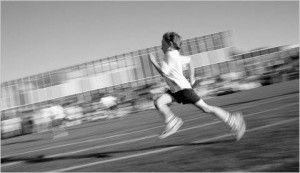A few days ago I received a challenging question from a good friend of mine, personal trainer and coach, Jurjen Groen, and the question was: “what is do you consider to be “natural movement” ?”.
An interesting and intriguing question for sure. I’ll share my answer with you.
Natural movement is clearly is misnomer, just like natural food or natural breathing. Most of the time we assume natural equals “good”, “positive” of “healthy” , conveniently forgetting the fact that natural disasters, natural diseases and natural poisons are not that good, positive or healthy for us.
Or perhaps the intention of the term “natural movement “ was to point to self-learned movements like a baby crawls, stands up or walks, without the help of parents, teachers or coaches, without education, practice or training. Some coaches might even advocate “natural”, “unspoilt” movements where other believe in a strictly guided, controlled way of improving movements.
Some coaches like to show how well young children run, jump and hit without practice or correction.
But then, we have all seen their movement patterns change “naturally” as they get older, the 9 year old “smooth leopard” might change into a 16 year old giraffe. The 10 year old “gracious gazelle” changes into a 15 year old hippopotamus, caused by “natural” development, and this is caused by “natural” hormones.
There is a tremendous difference in how people move, some of it might be due to learning the wrong patterns consciously, (“my coach always to me to …..”), some of it came naturally and was never corrected properly, whereas others, call them the lucky ones, were simply born/designed to run, to swim, to jump smooth almost looking effortless.
We only know that movement is one of the integral characteristics of living organisms.(and sitting will become the new smoking)
Now what is a “natural” movement: natural movement is very limited, walking, running, throwing (hammerthrow?), jumping (Fosbury flop?), lifting, climbing, swimming, (butterfly or backstroke? ) , not to speak about cycling, speedskating, rowing, ), hitting a ball with a bat or racket? Most forms of human movements are designed by humans and never seen in the rest of the natural world. An elephant doesn’t climb trees, a giraffe doesn’t bike, a bee doesn’t swim, a snail doesn’t jump and a human being doesn’t fly like a bird does…. naturally.
If somebody is using the word “natural’ as related to movement be prepared to hear nonsense.
Some of my athletes made a decision to only eat natural foods, I always pity them, for having to eat raw food only, since a cow does not rinse its food nor cooks a grass soup, a leopard doesn’t fry or grill a steak of a gazelle or an antelope, and a shark doesn’t make sushi.
We have to accept the fact that although we are still part of our given natural environment, and that our bodies systems are largely still designed like the first humanoid species. But we try very hard to escape from our natural past. Our brain enables us to adapt to our environment , to change it around, to modify and manipulate, and even to destroy our environment for a limited, short term benefit, even at a global scale. And boy, are we getting good at it.
But Jurjen also posed a second question: what is “healthy” exercise.
My idea is that the “healthy” part of exercise is in the optimal form and the dosage.
We know that too little exercise (hypokinesia) isn’t healthy and is related to an increased risk of obesity, metabolic syndrome, diabetes, cardiovascular diseases, stroke, osteoporosis, etc. We also know that too much exercise can lead to fatigue, addiction and injuries, even lethal ones like in extreme sports.
Healthy exercise adds something to our heath and leaves no lasting metabolic damage of structural scars. It might increase the life span (even if it is just a little bit) and improves our quality of life.
An optimal form and dosage of exercise might slow down ageing-processes, whereas too little or too much exercise might speed these up.
The big problem is that we can only judge the impact of exercise on health afterwards and often after many years. It is very hard to predict if a specific form or dose of exercise for a specific individual will lead to a positive or negative contribution to his/her health, if it was only because we have no easy and reliable ways to predict the long-term effects of it. For example: we cannot foresee the effects of jumping and bounding on joints, the long-term effects of aerobic exercise on the cardiac system, or the effects of strenuous exercise on the immune system of metabolism.
The development of “genomics-based personalized exercise” might open a possibility to take out at least some of the guess-work of designing exercise programs for individuals, allowing us to foresee at least some of the responses of individuals to exercise.

